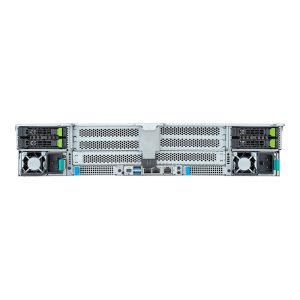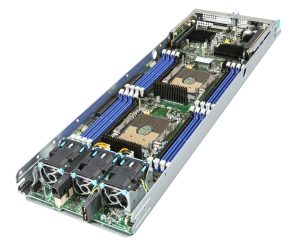Gigabyte 6NE283Z90DR000AAD1 server barebone Socket SP5 Stativ (2U) Rustfrit stål
38.310,00 kr. inkl. moms (ex. moms 30.648,00 kr.)
2U1N 2CPU 24XDIMM 4XHDD
Ikke på lager
Giv mig besked når varen kan købes

Powering the Next Generation of Server Architecture and Energy Efficiency
The path to AMD’s 5nm ‘Zen 4’ architecture was paved with many successful generations of EPYC innovations and chiplet designs, and AMD EPYC 9004 Series processors continue this progression. Adding a host of new features to target a wide range of workloads, the new family of EPYC processors will deliver even better CPU performance and performance per watt, and do so on a platform with 2x the throughput of PCIe 4.0 lanes that also has support for 50% more memory channels. For this new platform, GIGABYTE has products ready to get the most out of EPYC-based systems that support fast PCIe Gen5 accelerators and Gen5 NVMe drives, in addition to support for high performant DDR5 memory.
4th Gen AMD EPYC Processors for SP5 Socket
5nm architecture
Compute density increased with more transistors packed in less space
128 CPU cores
Dedicated cores and targeted workloads for Zen 4c & Zen 4 cores
Large L3 cache
Select CPUs have 3x or more L3 cache for technical computing
SP5 compatibility
All 9004 series processors are supported on one platform
12 channels
Memory capacity can achieve 6TB per socket
DDR5 memory
Increased memory throughput and higher DDR5 capacity per DIMM
PCIe 5.0 lanes
Increased IO throughput achieving 128GB/s bandwidth in PCIe x16 lanes
CXL 1.1+ support
Disaggregated compute architecture possible via Compute Express Link
High Performance
Servers and motherboards by GIGABYTE are tested to ensure peak performance for demanding CPU workloads. All the latest technology is supported.
Compute Density
One single socket solution can outperform many dual CPU servers. Dual socket models also support 192 cores in a 1U chassis. More compact performance.
Fast & Stable Connectivity
Keeping pace with the challenges for next gen technology, well designed GIGABYTE boards provide users the signal integrity for PCIe 5.0
Modularity
Our building block design allows new models to quickly come to market. And users can now have BMC on a OCP module customized by GIGABYTE.
Collaboration
AMD and GIGABYTE have maintained a healthy relationship that values shared knowledge in order to get the latest technology into data centers.
Optimal Price
Our broad portfolio of products and models allows customers to only select the features they require while doing so at a lower TCO.
Automatic Fan Speed Control
GIGABYTE servers are enabled with Automatic Fan Speed Control to achieve the best cooling and power efficiency. Individual fan speeds will be automatically adjusted according to temperature sensors strategically placed in the servers.
Cold Redundancy
To take advantage of the fact that a PSU will run at greater power efficiency with a higher load, GIGABYTE has introduced a power management feature called Cold Redundancy for servers with N+1 power supplies. When the total system load falls lower than 40%, the system will automatically place one PSU into standby mode, resulting in a 10% improvement in efficiency.
Smart Ride Through (SmaRT)
To prevent server downtime and data loss as a result of loss of AC power, GIGABYTE implements SmaRT in all our server platforms. When such an event occurs, the system will throttle while maintaining availability and reducing power load. Capacitors within the power supply can supply power for 10-20ms, which is enough time to transition to a backup power source for continued operation.
Smart Crises Management and Protection (SCMP)
SCMP is a GIGABYTE patented feature which is deployed in servers with non-fully redundant PSU design. With SCMP, in the event of faulty PSU or overheated system, the system will force the CPU into an ultra-low power mode that reduces the power load, which prevents the system from unexpected shutdown and avoids component damage or data loss.
Dual ROM Architecture
If the ROM that stores the BMC and BIOS fails to boot, the system will reboot with the backup BMC and/or BIOS replacing the primary. Once the primary BMC is updated, the ROM of the backup BMC will automatically update the backup through synchronization. For the BIOS, it can be updated based on user’s choice of firmware version.
Optional TPM 2.0 Module
For hardware-based authentication, the passwords, encryption keys, and digital certificates are stored in a TPM module to prevent unwanted users from gaining access to your data. GIGABYTE TPM modules come in either a Serial Peripheral Interface or Low Pin Count bus.
Tool-less Drive Bays Design
Clipping mechanism secures the drive in place. Install or replace a new drive in seconds.
OCP 3.0 Ready
GIGABYTE offers servers that feature an onboard OCP 3.0 slot for the next generation of add on cards. Advantages of this new type include:
Easy Serviceability:
Simply slot in or pull out the card, without opening the server or using tools
Improved thermal design:
Horizontal position and optimal heat sink design allow for air cooling to eliminate the heat efficiently
Certified Ready with Software Partners
Being a member of key software alliance partner programs enables GIGABYTE to rapidly develop and validate joint solutions, enabling our customers to modernize their data centers and implement IT infrastructure and application services with speed, agility, and cost optimization.
GIGABYTE Management Console
For management and maintenance of a server or a small cluster, users can use the GIGABYTE Management Console, which is pre-installed on each server. Once the servers are running, IT staff can perform real-time health monitoring and management on each server through the browser-based graphical user interface. In addition, the GIGABYTE Management Console also provides:
Support for standard IPMI specifications that allows users to integrate services into a single platform through an open interface
Automatic event recording, which can record system behavior 30 seconds before an event occurs, making it easier to determine subsequent actions
Integrate SAS/SATA/NVMe devices and RAID controller firmware into GIGABYTE Management Console to monitor and control Broadcom® MegaRAID adapters.
GIGABYTE Server Management (GSM)
GSM is a software suite that can manage clusters of servers simultaneously over the internet. GSM can be run on all GIGABYTE servers and has support for Windows and Linux. GSM can be downloaded from GIGABYTE website and complies with IPMI and Redfish standards. GSM includes a complete range of system management functions that includes the following utilities:
GSM Server: A software program that provides real-time, remote control using a graphical user interface through an administrator’s computer or through a server in the cluster. The software allows ease of maintenance for large clusters of servers.
GSM CLI: A command-line interface for monitoring and managing remotely.
GSM Agent: A software program installed on each GIGABYTE server node that retrieves information from each system and devices through the OS, and this software integrates with GSM Server or GSM CLI.
GSM Mobile: A mobile app for both Android and iOS that provides admins with real-time system information.
GSM Plugin: An application program interface that allows users to use VMware vCenter for real-time monitoring and management of server clusters.
| Vægt | 0,0000 kg |
|---|---|
| Indbygget processer | Ingen |
| Brand | Gigabyte |
| State | Default |
| Antal understøttede processorer | 2 |
| Processorproducent | AMD |
| Antal DIMM-slots | 24 |
| Understøttede hukommelsestyper | DDR5-SDRAM |
| Antal understøttede lagerdiske | 4 |
| Hot-swap HDD båse | Ja |
| Antal 2.5" bays | 2 |
| Understøttede lagerdisk størrelser | 2.5" |
| Understøttede lagerdrev brugerflader | SATA, Serial Attached SCSI (SAS) |
| Ethernet LAN | Ja |
| Ethernet-grænsefladetype | Gigabit Ethernet |
| Ethernet LAN-porte (RJ-45) | 2 |
| Antal USB 3.2 Gen 1 (3.1 Gen 1) type-A-porte | 4 |
| Trusted Platform Module (TPM) | Ja |
| Kabinettype | Stativ (2U) |
| Produktfarve | Rustfrit stål |
| LED-indikatorer | HDD, LAN, Node ID, Strøm, System |
| Hot-swap PSU | Ja |
| Bredde | 438 mm |
| Dybde | 625 mm |
| Højde | 87 mm |
| Processor sokkel | Socket SP5 |
| Maksimal intern hukommelse | 256 GB |
| Maksimal RDIMM hukommelse | 96 GB |
| Understøttet RDIMM-clockhastigheder | 4800 MHz |
| Ethernet LAN-datahastigheder | 10,100,1000 Mbit/s |
| PCI Express slots version | 5.0 |
| PCI Express x16 slots | 6 |
| Trusted Platform Module (TPM) version | 2.0 |
| Rack skinner | Ja |
| Mulighed for at installere sammen med rack | Ja |
| Strømforsyning | 1600 W |
| On-board grafikkort | Ja |
| Understøttet datalagringsdrev typer | HDD & SSD |
| On-board grafikkort, model | Aspeed AST2600 |
| LAN Kontroller | Intel® I350-AM2 |
| Knap til nulstilling | Ja |
| Antal blæsere | 4 blæser(e) |
| Ventilator diameter | 8 cm |
| Vekselstrømsindgangsspænding | 110 – 240 V |
| Vekselstrømsindgangsfrekvens | 50/60 Hz |
| 80 PLUS certificering | 80 PLUS Platinum |
| Driftstemperatur (T-T) | 10 – 35 °C |
| Opbevaringstemperatur (T-T) | -40 – 60 °C |
| Relativ luftfugtighed ved drift (H-H) | 8 – 80% |
| Relativ luftfugtighed ved opbevaring (H-H) | 20 – 95% |
| Tænd-/slukkontakt | Ja |
| Pakkebredde | 982 mm |
| Pakkedybde | 588 mm |
| Pakkehøjde | 268 mm |
| Indgangsstrøm | 12 A |
| Thermal Design Power (TDP) | 300 W |
| SSD-formfaktor | 2.5" |
| Kølingstype | Aktiv |
| Antal af hovedstrømforsyninger | 2 |
| Hukommelseskanaler | Dodeca-kanal |
| Processorserie | AMD EPYC 9004 Series |
| Pufret hukommelsestype | Registered (buffered) |
| DC udgående strøm (+12 V) | 133 A |
| Antal M.2 (M) slots | 2 |
| Antal mini DisplayPorts | 1 |
| Processorgeneration | AMD EPYC 9004 |
| Antal understøttede hot swap-PSU'er | 2 |
























